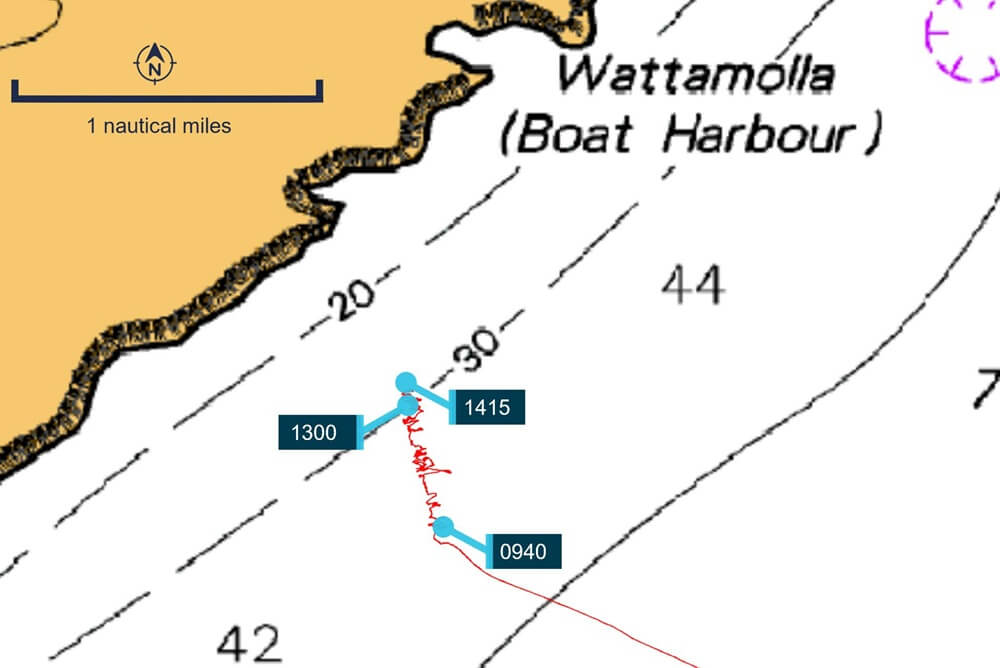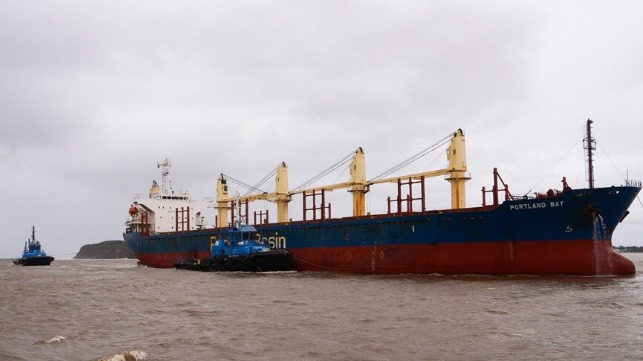ATSB: Delayed Response Raised Risk of Grounding for Drifting Bulker

The Australian Transport Safety Bureau has released a final report on the double near-grounding of a bulker near Sydney in 2022, and it roundly criticized emergency-management officials for a series of delays in dispatching a full-size response tug. With just three harbor tugs dispatched to help, all too small to be of assistance, it was up to the vessel's crew to save their own ship - and the absence of an oceangoing tug prolonged the risk, according to ATSB.
On July 3, 2022, the bulker Portland Bay was moored at Port Kembla, New South Wales. A storm approached, and the master and harbormaster decided it would be safer for the bulker to weather out the conditions at sea. Portland Bay got under way and steamed to an area about 12-15 nautical miles off the coast, where she maneuvered at a slow bell or drifted with the engine off, rolling heavily in gale-force winds and heavy swell. Significant wave heights of about 15 feet were recorded at a nearby metocean buoy.
At about 0500 hours on the morning of July 4, an auxiliary blower on Portland Bay's main engine broke down. This limited speed to dead slow ahead and effectively left the ship disabled, beam to the seas and drifting towards shore at 2-3 knots. For the next two hours, the crew attempted to make emergency repairs to the main engine, but were not successful.
Two hours later, at 0656, the chief mate made a call on VHF and informed the Port Kembla VTS center that the main engine had failed, and he requested tug assistance. The VTS center passed this information on to the ship's agent and notified the Port Authority of New South Wales of the ship's situation.
At this point, Portland Bay was just six miles off the coast and drifting at more than four knots towards shore. At this speed, the master noted, the ship would be on the rocks within an hour and a half.
At 0725, half an hour after the first distress call, the Sydney VTS center - which had overheard the radio traffic - made the first move to provide towage. After a few calls, local operator Engage Towage began preparing small harbor tug SL Diamantina to respond to the scene. Svitzer also began to mobilize the harbor tug Bullara out of Sydney. Neither vessel was designed for open-ocean towage in gale-force conditions.

Portland Bay's AIS trackline on July 4, 2022 (ATSB)
As the Portland Bay drifted closer to shore, shallower water created an opportunity for emergency anchoring. At 0901-0915, the ship's crew let go both anchors, then stopped the engine. The anchors held in 150 feet of water, about one mile off the shore. However, the ship's ground tackle was not designed for gale-force conditions, and the Portland Bay continued to drag slowly eastward.
At about 1010, SL Diamantina arrived, and the Portland Bay's master asked it to push on the starboard side to reduce tension on the anchor cables. In heavy swells, the small Diamantina hit Portland Bay's hull repeatedly, and the operation was discontinued to avoid serious damage. Instead, at 1040, the tug began a series of attempts to rig a tow using the ship's mooring lines (wire ropes). The mooring wires were connected to the tug's synthetic tow line three times, but parted every time in the heavy seas - first at 1158, then again at 1230, then again at 1304. Two other small harbor tugs - SL Martinique and Bullara - soon arrived on scene and rigged their own towlines to the ship's bow, allowing SL Diamantina to step back.
Portland Bay was still dragging slowly towards shore and was now just seven cables off the beach. The engineering crew was working as fast as possible to rig a repair to the blower system and get the main engine back online. These repairs appeared successful at last, and at 1430, the operator advised that the vessel was ready to make half ahead.
At 1538, with propulsion restored and two tugs connected, Portland Bay weighed anchor and got under way with engine ahead slow. But just nine minutes later, the engine had to be shut down again because of high temperatures and scavenge space fires, leaving the ship wholly reliant on the two tugs pulling on the bow.
Bullara's towline failed at 1835, and SL Martinique was not able to continue the tow on its own. For the second time in a day, Portland Bay's master deployed anchors to avert a grounding.
Throughout these evolutions, emergency response tug Svitzer Glenrock remained at berth at the port of Newcastle, 90 miles away. In part because of communication issues, this larger and more capable tug was not ordered to deploy until about 2000 - fifteen hours after the beginning of the emergency - and the Glenrock's crew did not get under way from the pier until 2230.
Svitzer Glenrock battled 25-foot seas and 40-knot waves on the way south, and at times the tug could only make a speed over ground of five knots. It finally arrived on scene at about 1300 hours on July 5, and the crew connected to the towline at 1515. Assisted by multiple harbor tugs, Svitzer Glenrock got under way with Portland Bay in tow on the morning of July 6, arriving in the harbor at Port Botany that afternoon.

Portland Bay arrives at Port Botany, July 6, 2022 (AMSA)
Based on an after-accident inspection, ATSB found that Portland Bay's engine was operating with a leaky fuel injector, excessive cylinder lubrication and excess fuel injection, creating a buildup of sludge and deposits. In the heavy swells on July 3-4, engine load and RPM fluctuated widely, leading to turbocharger surge. One bent scavenge air non-return flap for the turbocharger caused reduced airflow. All this led to poor combustion, deposit accumulation and blowby, progressively degrading engine performance - and when the number two auxiliary blower went out, the engine no longer had enough airflow to make full speed. (An imbalanced impeller and worn bearing housings from a previous repair may have also contributed to the blower's failure.)

Damage and deposit accumulation in Portland Bay's main engine (ATSB)
In ATSB's final report, the crew and operator came in for criticism for the two-hour delay between the time that the vessel lost propulsion and the time that the first call for help went out. ATSB also found fault with local and national authorities for their response. There were several hours of initial confusion over management until the Port Authority of New South Wales assumed control at 1020 hours on July 4. At that point, the vessel had already anchored.
ATSB took particular issue with the Australian Maritime Safety Authority (AMSA) for not activating the region's designated emergency response tug - Svitzer Glenrock - until 15 hours after the incident began. Even if the Glenrock was based too far away to help immediately on the morning of the 4th, the delay in mobilizing the tug prolonged the emergency; it was the only asset in the region that was rated for the task and should have been activated right away, ATSB said.
"Whilst the first responding tugs received a lot of praise for their actions in what were really challenging conditions, ultimately the three tugs that were dispatched were harbor tugs," said ATSB chief commissioner Angus Mitchell. "They were ill-equipped and not capable of the task at hand - nor were they ever going to be, based on what their known characteristics and capacities were. It was only the emergency deployment of the ship's anchors on two separate occasions that prevented the ship from stranding."
